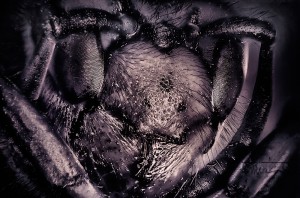Slicing your way through the details
Shooting small subjects with a microscope objective allows for some amazing imaging opportunities. The micro world that exists all around us is full of amazing details that can only be appreciated through magnification.
This yellow jacket has a face that only the queen could love. Although, I am not sure if queens are part of the yellow jacket family. I am amazed at the details of the compound eyes, the pores in the face and the hairiness of this critter.
Most macro lenses allow for a 1:1 magnification. That means that the subject will be the same scale on the sensor as it is in real life. To achieve higher magnifications, requires extending the lens further away from the image plane. Another way to achieve this is with microscope objective.
To shoot this guy, I used a vintage 4x microscope objective mounted to a series of extension tubes and a macro bellows. The bellows was mounted to a Pentax DSLR with an APS size sensor. The final image was produced with 20 exposures using a StackShot Macro Rail to achieve sharp focus from the desired foreground to background details. Each slice reveals a new layer of detail, which is then processed with stacking software.
There are a few stacking packages available for both Mac and PC. I have used both Zerene Stacker and Helicon Focus on the Mac. While I think both are worthy products for shooting macro stacks, it is my opinion that Zerene Stacker has a more robust algorithm. I find it to be easier to use, more reliable, and produces what I feel are superior results.
Most subjects shot with focus stacking need to be immobilized. Any movement during the process will ruin the stack. This wasp was as dead as a doorknob, which was the way I found him. Living insects can be photographed, however, the method of capture is very different.
Once you have a specimen to shoot, a good quality objective, the proper length of bellows and tubes, the hardest part is lighting the subject. In this case, the exposures were made with an electronic flash very near the subject that was diffused with a few layers of translucent plastic.
Because the lens objective does not have apertures, reducing the output from the electronic flash to 1/4 of its normal power produced the exposure for each of the 20 shots. Each shot received a full exposure from the 1/4 flash setting.
To achieve a dark and menacing appearance, I finished the process in Photomatix Pro, Photoshop, NIK Silver Efex and Flaming Pear Kyoto Color software.
I’ll be writing much more about macro stacking in future postings.
NOTICE of Copyright: THIS POSTING AS WELL AS ALL PHOTOGRAPHS, GALLERY IMAGES, AND ILLUSTRATIONS ARE COPYRIGHT © JOHN NEEL AND ARE NOT TO BE USED FOR ANY PURPOSE WITHOUT WRITTEN CONSENT FROM THE WRITER, THE PHOTOGRAPHER AND/OR lensgarden.com. THE IDEAS EXPRESSED ARE THE PROPERTY OF THE PHOTOGRAPHER AND THE AUTHOR.



